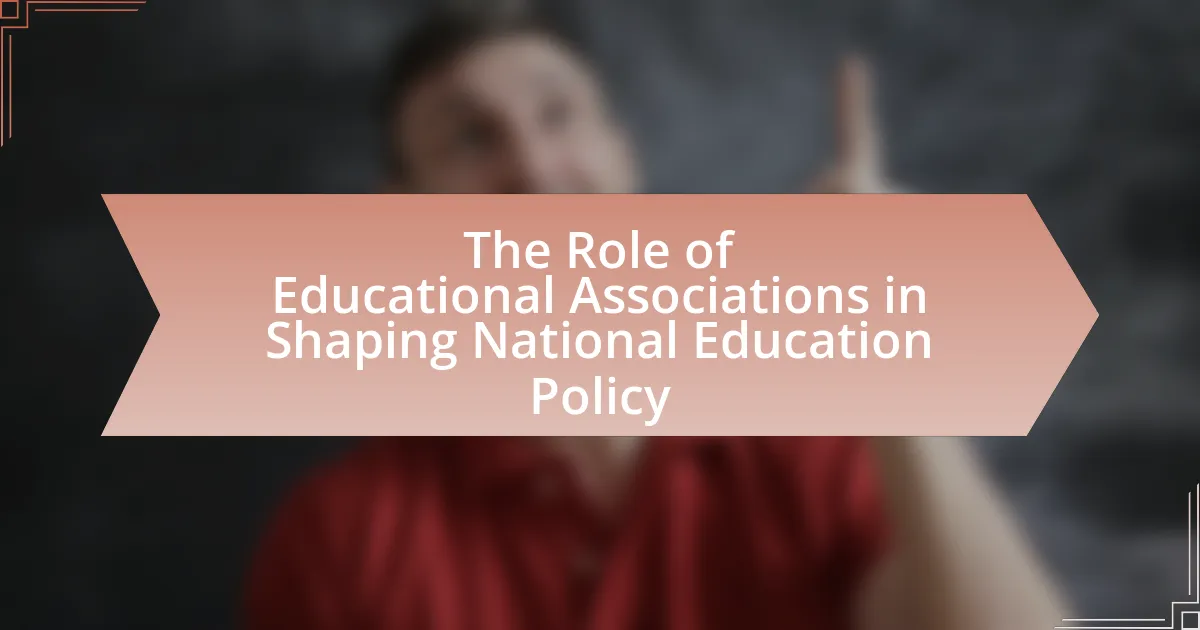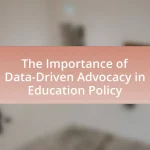Educational associations, such as the National Education Association (NEA) and the American Federation of Teachers (AFT), play a vital role in shaping national education policy by advocating for educators’ interests and influencing legislative decisions. They employ strategies like lobbying, grassroots mobilization, and research dissemination to promote educational reforms and secure funding. These associations collaborate with government entities to align educational practices with national goals, while also facing challenges such as limited resources and competing interests. Their unique perspectives and collective voice are essential in representing the needs of educators and students, ultimately impacting policy development and educational outcomes.

What is the role of educational associations in shaping national education policy?
Educational associations play a crucial role in shaping national education policy by advocating for the interests of educators and influencing legislative decisions. These associations, such as the National Education Association (NEA) and the American Federation of Teachers (AFT), engage in lobbying efforts, provide research and data to policymakers, and mobilize their members to participate in the political process. For instance, the NEA has been instrumental in promoting policies that support increased funding for public education and equitable access to resources, which are critical for improving educational outcomes. Their influence is further evidenced by their ability to organize grassroots campaigns that raise awareness and drive public support for specific educational reforms, thereby directly impacting policy development at the national level.
How do educational associations influence policy decisions?
Educational associations influence policy decisions by advocating for specific educational reforms and representing the interests of their members. These associations engage in lobbying efforts, provide research and data to policymakers, and mobilize their members to participate in advocacy campaigns. For example, the National Education Association (NEA) has been instrumental in shaping legislation related to teacher salaries and classroom funding through its extensive lobbying efforts and grassroots mobilization, demonstrating their significant impact on education policy at both state and federal levels.
What strategies do educational associations use to advocate for policy changes?
Educational associations utilize several strategies to advocate for policy changes, including lobbying, grassroots mobilization, and research dissemination. Lobbying involves direct interaction with policymakers to influence legislation, often supported by data and expert testimony. Grassroots mobilization engages members and the public to raise awareness and demonstrate support for specific policies, leveraging collective action to amplify their voice. Research dissemination provides evidence-based insights that inform policymakers about the implications of proposed changes, ensuring that decisions are grounded in solid data. For instance, the National Education Association frequently employs these strategies to influence education funding and reform initiatives at both state and federal levels.
How do educational associations collaborate with government entities?
Educational associations collaborate with government entities through advocacy, policy development, and resource sharing. These associations represent the interests of educators and institutions, providing a unified voice to influence educational policy decisions. For instance, the National Education Association (NEA) actively engages with lawmakers to shape legislation that impacts education funding and standards. Additionally, educational associations often participate in advisory committees and task forces, offering expertise and research to inform government initiatives. This collaboration is essential for aligning educational practices with national goals, as evidenced by the Every Student Succeeds Act (ESSA), where input from educational associations was crucial in its formulation.
Why are educational associations important in the education sector?
Educational associations are important in the education sector because they advocate for policies that enhance educational quality and access. These organizations represent the interests of educators, administrators, and stakeholders, influencing legislation and funding decisions that shape educational practices. For instance, the National Education Association (NEA) plays a crucial role in lobbying for teacher rights and educational reforms, impacting national policy through research and collective bargaining. Their efforts contribute to the development of standards and best practices, ensuring that educational systems meet the needs of diverse populations.
What unique perspectives do educational associations bring to policy discussions?
Educational associations bring diverse perspectives to policy discussions by representing the collective interests of educators, administrators, and stakeholders in the education sector. These associations provide insights based on empirical research, practical experiences, and the needs of their members, which can inform policy decisions. For instance, the National Education Association (NEA) advocates for policies that prioritize equitable funding and access to quality education, reflecting the concerns of teachers and students across various demographics. Their involvement ensures that policy discussions are grounded in the realities of classroom experiences and educational outcomes, thereby enhancing the relevance and effectiveness of proposed policies.
How do educational associations represent the interests of educators and students?
Educational associations represent the interests of educators and students by advocating for policies that enhance educational quality and access. These associations engage in lobbying efforts to influence legislation, provide professional development resources, and facilitate communication between educators and policymakers. For instance, the National Education Association (NEA) actively campaigns for increased funding for public schools and equitable educational opportunities, reflecting the collective voice of its members. Additionally, educational associations conduct research and disseminate findings that inform best practices in teaching and learning, thereby supporting both educators and students in achieving academic success.
What challenges do educational associations face in influencing national education policy?
Educational associations face significant challenges in influencing national education policy, primarily due to limited resources and competing interests. These associations often operate with constrained budgets, which restrict their ability to conduct extensive research, advocacy campaigns, and outreach efforts necessary for effective policy influence. Additionally, they encounter competition from various stakeholders, including government entities, private organizations, and other interest groups, each vying for attention and resources in the policymaking process.
Furthermore, educational associations may struggle with fragmentation within their own ranks, leading to divergent priorities and weakened collective action. This fragmentation can dilute their influence and make it difficult to present a unified front to policymakers. The complexity of the political landscape also poses a challenge, as shifting political climates and varying levels of support for education reform can hinder the effectiveness of their advocacy efforts.
For instance, a report by the National Education Association highlights that despite their efforts, educational associations often find it challenging to secure a seat at the table during critical policy discussions, particularly when budgetary constraints lead to prioritization of other sectors over education.
How do political dynamics affect the effectiveness of educational associations?
Political dynamics significantly influence the effectiveness of educational associations by shaping their advocacy strategies and resource allocation. For instance, when political support for education is strong, educational associations can more effectively lobby for policy changes and secure funding, as seen in the increased federal funding for education initiatives during administrations prioritizing educational reform. Conversely, in politically hostile environments, these associations may face challenges such as reduced influence in policy discussions and limited access to decision-makers, which can hinder their ability to advocate for necessary reforms. Historical examples include the impact of the No Child Left Behind Act, where educational associations played a crucial role in shaping policy due to favorable political conditions, demonstrating that the political landscape directly affects their operational effectiveness and overall impact on national education policy.
What are the limitations of educational associations in policy advocacy?
Educational associations face several limitations in policy advocacy, primarily due to their reliance on member consensus, which can hinder decisive action. These organizations often represent diverse interests, leading to conflicting priorities that complicate unified advocacy efforts. Additionally, limited financial resources restrict their ability to conduct comprehensive research or engage in extensive lobbying activities. Furthermore, educational associations may lack the political influence necessary to effect significant policy changes, as they often compete with more powerful stakeholders, such as government entities and large corporations. These factors collectively diminish their effectiveness in shaping national education policy.
How do educational associations adapt to changing educational landscapes?
Educational associations adapt to changing educational landscapes by actively engaging in policy advocacy, professional development, and research initiatives. These organizations monitor trends in education, such as technological advancements and shifts in pedagogical approaches, to inform their strategies. For instance, the National Education Association (NEA) has implemented programs that address the integration of technology in classrooms, reflecting the increasing importance of digital literacy in education. Additionally, educational associations often collaborate with stakeholders, including government agencies and educational institutions, to influence policy decisions that align with contemporary educational needs. This collaborative approach ensures that they remain relevant and responsive to the evolving demands of the educational environment.
What specific roles do different types of educational associations play?
Different types of educational associations play crucial roles in shaping national education policy by advocating for specific interests, providing professional development, and facilitating research and collaboration among educators. For instance, teacher associations advocate for educators’ rights and influence policy decisions at local and national levels, while subject-specific associations focus on advancing curriculum standards and best practices in their respective fields. Additionally, associations often conduct research that informs policy, such as the National Education Association’s studies on educational equity, which provide data-driven insights that policymakers rely on to make informed decisions. These roles collectively contribute to the development and implementation of effective educational policies that address the needs of students and educators.
How do professional associations differ from advocacy groups in education?
Professional associations in education primarily focus on supporting the professional development and interests of their members, such as teachers and administrators, by providing resources, networking opportunities, and professional standards. In contrast, advocacy groups aim to influence public policy and promote specific educational reforms or issues, often representing broader societal interests rather than individual professionals. For example, the National Education Association (NEA) serves as a professional association by offering training and resources for educators, while organizations like Teach Plus act as advocacy groups by campaigning for policy changes in education. This distinction highlights that professional associations prioritize member support and development, whereas advocacy groups concentrate on policy influence and social change.
What role do grassroots organizations play in shaping education policy?
Grassroots organizations play a crucial role in shaping education policy by mobilizing community members to advocate for changes that reflect local needs and priorities. These organizations often engage in activities such as organizing campaigns, conducting research, and lobbying policymakers to influence legislation and funding decisions. For instance, the National Education Association (NEA) has historically supported grassroots initiatives that empower teachers and parents to voice their concerns, leading to significant policy reforms at both state and federal levels. Additionally, grassroots movements have been instrumental in addressing issues like equitable funding and access to quality education, demonstrating their impact on shaping educational outcomes and policies.
What are the best practices for educational associations in policy advocacy?
Educational associations should engage in collaborative partnerships, utilize data-driven advocacy, and maintain transparent communication as best practices in policy advocacy. Collaborative partnerships with stakeholders, including educators, policymakers, and community organizations, enhance the credibility and reach of advocacy efforts. Data-driven advocacy, supported by research and statistics, strengthens arguments and demonstrates the impact of proposed policies on education outcomes. Transparent communication fosters trust and encourages stakeholder engagement, ensuring that diverse perspectives are considered in the advocacy process. These practices are essential for effectively influencing national education policy and achieving desired educational reforms.
How can educational associations effectively engage with stakeholders?
Educational associations can effectively engage with stakeholders by fostering collaboration through regular communication, inclusive events, and targeted outreach initiatives. These associations can organize workshops, conferences, and forums that bring together educators, policymakers, and community members to discuss educational issues and share best practices. For instance, the National Education Association (NEA) regularly conducts surveys and focus groups to gather input from its members, ensuring that stakeholder voices are heard in policy discussions. This approach not only enhances transparency but also builds trust and strengthens relationships among stakeholders, ultimately leading to more informed and effective educational policies.
What methods can educational associations use to measure their impact on policy?
Educational associations can measure their impact on policy through various methods, including surveys, policy analysis, and case studies. Surveys can gather feedback from stakeholders about the perceived influence of the association’s initiatives on policy changes. Policy analysis involves examining legislative outcomes and correlating them with the association’s advocacy efforts, providing quantitative data on policy shifts. Case studies can illustrate specific instances where the association’s actions led to significant policy changes, offering qualitative insights into their effectiveness. These methods collectively provide a comprehensive understanding of the association’s role in shaping educational policy.


